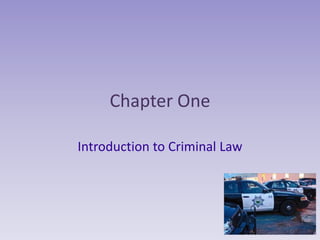
Chapter 1
- 1. Chapter One Introduction to Criminal Law
- 2. Definition of a Crime • An act committed in violation of a law prohibiting it • An act omitted in violation of a law ordering it • The government must enact the criminal law before it can punish an individual • Criminal laws vary greatly from state to state
- 3. Criminal Law and Criminal Procedure • Criminal law: as a topic, covers crimes and defenses to crimes • Criminal procedure: as a topic, covers individual’s rights during the criminal process, such as investigation, arrest, and prosecution
- 4. Comparing Civil and Criminal Law • Civil law has to do with the private rights of individuals/businesses • When individuals have a dispute with other individuals, this dispute can be resolved with a civil lawsuit, also called civil litigation • When the civil litigation involves an injury, the injury action is called a tort
- 5. Criminal Prosecution • The government prosecutes a wrongdoer to protect the public, rather than an individual suing another individual/business • One set of facts could give rise to a civil litigation matter and a criminal prosecution without violating the principle against double jeopardy (example: O.J. Simpson case)
- 6. Characteristics of Civil Litigation • The individual/business suing is called the plaintiff • The individual/business being sued is called the defendant • The goal is compensation for an injury • Compensation awarded by the court is called damages
- 7. In a Civil Litigation Matter: • If the plaintiff and defendant want legal representation, they will be represented by private attorneys • There is no right to a free attorney, so the defendant must pay for a private attorney even if he/she did nothing wrong • If the defendant cannot afford a private attorney in civil litigation, the defendant must represent himself/herself
- 8. Damages: • Compensatory: compensate for the injury • Costs: compensate for the costs of suing, including attorney’s fees • Punitive: punish the defendant
- 9. Harm Requirement: • Because the goal of civil litigation is to compensate for harm, the plaintiff must be able to prove harm/bad result • Without harm, or a victim, the lawsuit will be dismissed
- 10. Because Compensation is the Goal: • Fault is not necessarily a requirement • Sometimes, a defendant will be liable in civil litigation if not at fault • Strict liability: a tort without a “bad intent” requirement • Respondeat Superior: the employer may be liable for an injury caused by an employee based on ability to pay-even if not at fault
- 11. Characteristics of Criminal Prosecution • The government prosecutes, rather than an individual plaintiff • In a state crime, the government is sometimes referred to as “The People” (of the state of. . .) • In a federal crime, the government is the USA • The state government is represented by a prosecutor, often called a District Attorney • The federal government is represented by a prosecutor called the United States Attorney
- 12. The Wrongdoer in a Criminal Prosecution: • Is called the defendant, just like civil litigation • The defendant can be an individual or business
- 13. Because the Government is Prosecuting. . . • The Constitution governs the proceedings • This means the defendant gets special protections • Freedom from double jeopardy, self- incrimination, and the right to counsel • The defendant will get a free attorney (called a public defender) if facing incarceration and unable to afford attorney’s fees
- 14. The goal of a Criminal Prosecution: • Punishment • No need for a victim or harm
- 15. Comparison of Civil and Criminal: Civil: Criminal • Parties are called plaintiff • Parties are state/federal and defendant government and defendant • Plaintiff and defendant • Defendant may get a free must pay for private attorney if he/she can’t attorneys afford one and facing • Goal is compensation for incarceration injury • No constitutional • Goal is punishment protections • Constitutional protections • Harm is a requirement • Victim/harm not required
- 16. Classification of Crimes • Felony: most serious, and all range of sentencing options available, incarceration is in prison • Felony-misdemeanor: can be prosecuted as a felony or misdemeanor, depending on the circumstances • Misdemeanor: less serious, jail rather than prison • Infraction: least serious; traffic ticket-fine or alternative sentencing
- 17. Purposes of Punishment • Deterrence: scares people into obeying the law. General-the public is deterred. Specific: the defendant is deterred. • Incapacitation: removes the offender from society • Rehabilitation: reforms the offender • Retribution: gives the public satisfaction • Restitution: compensates the victim/government for harm financially
- 18. Sources of Law • The places where law comes from • Constitution, statutes, cases
- 19. Constitution • Highest source of law • Only applies to government action. Intended to regulate the government to protect the private rights of individuals • Individuals are protected by the Constitution, but do not have to abide by it • One federal Constitution, and every state has a state constitution
- 20. Statutes • Enacted by the federal legislature (Congress) or state legislature • Statutes apply to individuals/businesses • Includes ordinances, which are enacted by a city or county • Cannot conflict with or attempt to supersede the Constitution
- 21. Case Law • Created by judges • Generally an appeal, rather than a trial • Based on English common-law principles • Case law interprets statutes and the Constitution so is very powerful, although technically inferior to statutory law • Judicial review: a case can invalidate a statute if it is unconstitutional
- 22. Case Briefing: • Highlights the most important aspects of a judicial opinion • Review the Keeler case brief in chapter one for a brief format